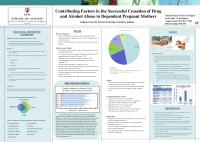Neonatal abstinence syndrome, increasing surveillance in newborns
View File(s)
- Author(s)
- Details
-
Lindsey N. Clark, DNP, APRN, CPNP-PC
- Sigma Affiliation
- Omicron Iota at-Large
Visitor Statistics
Visits vs Downloads
Visitors - World Map
Top Visiting Countries
| Country | Visits |
|---|
Top Visiting Cities
| City | Visits |
|---|
Visits (last 6 months)
Downloads (last 6 months)
Popular Works for Clark, Lindsey N. by View
| Title | Page Views |
|---|
Popular Works for Clark, Lindsey N. by Download
| Title | Downloads |
|---|
View Citations
Citations
The purpose of this project was to improve nursing staff’s knowledge of Neonatal Abstinence Syndrome, identifiable risk factors, how to screen for Neonatal Abstinence Syndrome, and how to report positive findings from the Neonatal Abstinence Syndrome screen. The goal for implementation of this intervention was to improve the rates of Neonatal Abstinence Syndrome screening in the newborn nursery.
The background included staff education on how to initiate the NAS screening tool, newborns at risk will have a nursing staff who are hypervigilant to any abnormalities and the need for any interventions beyond normal newborn care. When infants are identified for NAS, they are then placed under ongoing surveillance by the hospital staff and the pediatric provider.
The methods used in this quality improvement project had a comparative design that was developed around an education intervention provided to the nursing staff. Once the education was provided, a retrospective chart audit was performed. The purpose of this method was to compare the NAS scoring pre-education to a hypothesized improvement in NAS scoring after the education delivery.
The results of the study were obtained within a 20 bed Level II nursery within a regional medical center that serves a city of approximately 29,000 along with multiple outlying communities. The vulnerable newborn population has been falling through the cracks with inconsistent surveillance and undereducated nursing staff regarding Neonatal Abstinence Syndrome. This small, controlled environment was the ideal size for a quality improvement project that aims to improve surveillance based on the presence of risk factors. This quality improvement project used a comparative quantitative research method to determine statistical significance for the intervention provided in evaluating pre-intervention data with postintervention data.
In conclusion, with the significance in the increase in NAS screening rates post-education to pre-education, and a significant power analysis, this study showed evidence of a true change. In summary, there was statistical evidence to show an increase in NAS screening after the educational intervention as initially hypothesized.
The author still retains copyright.
This item has not gone through this repository's peer-review process, but has been accepted by the indicated university or college in partial fulfillment of the requirements for the specified degree.
| Type | Dissertation |
| Acquisition | Proxy-submission |
| Review Type | None: Degree-based Submission |
| Format | Text-based Document |
| Evidence Level | Quality Improvement |
| Research Approach | Quantitative Research |
| Keywords | Vulnerable Newborn Population; Continuing Education; Screening Tools |
| Grantor | Maryville University |
| Advisor | Kern, Joanne; Keeling, Morgan; Vanderboom, Marrlene; McKown, Teri |
| Level | DNP |
| Year | 2022 |
All rights reserved by the author(s) and/or publisher(s) listed in this item record unless relinquished in whole or part by a rights notation or a Creative Commons License present in this item record.
All permission requests should be directed accordingly and not to the Sigma Repository.
All submitting authors or publishers have affirmed that when using material in their work where they do not own copyright, they have obtained permission of the copyright holder prior to submission and the rights holder has been acknowledged as necessary.
Related items
Showing items related by title, author, creator and subjects.
-
Experiences and perceptions of rural postpartum women with substance use disorders inclusive of opioids regarding their care
Kramlich, Debra L.Perinatal opioid use and neonatal withdrawal continue to rise rapidly in the face of the growing epidemic of opioid addiction in the United States, with rural areas more severely impacted. Despite several decades of research ... -
Interprofessional healthcare provider education on neonatal abstinence syndrome
Puchalski, MaryThe rapidly increasing incidence of Neonatal Abstinence Syndrome (NAS) in the U.S. has been identified as a national healthcare crisis. An evidence-based practice change project, “Interprofessional Healthcare Provider ... -
Non-pharmacologic interventions for the treatment of neonatal abstinence syndrome
Teal, Connie M.Neonatal abstinence syndrome (NAS) is a significant, growing problem. Non-pharmacological care for infants experiencing withdrawal is not well studied in the literature. A prospective quality improvement project was conducted ... -
Practice patterns in adherence to neonatal abstinence guidelines: A retrospective chart review
Gagnon, Robyn M. (2017-10-19)With the recent surge in the number infants diagnosed with Neonatal Abstinence Syndrome (NAS), this quality improvement project was completed to measure the number of deviations from NAS pharmacological management guidelines. ... -
Contributing factors in the successful cessation of drug and alcohol abuse in dependent mothers
Harper, Natalie; Duke, Emily (2017-10-19)This presentation focuses on the factors influencing mothers of newborns to either continue or discontinue use of drugs or alcohol during pregnancy. The desired outcome is to better understand barriers to cessation in hopes ...





